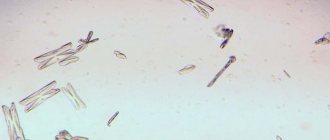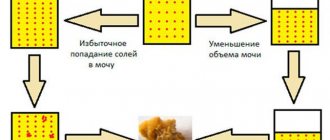What are calcifications?
Patients who have discovered calcifications are always interested in what this means? This term refers to the deposition of calcium salts that occurs in soft tissues. Similar accumulations can appear in different organs. They look like a kind of capsules containing destroyed tissue inside.
Calcifications replace dead or irreversibly changed cells. Most patients have not one, but several foci of calcification.
In medicine, calcification is considered a secondary process, preceded by inflammation or injury. Most often it becomes one of the symptoms of an existing disease.
Calcification may be local or systemic. In the first case, one of the organs is affected. Systemic pathology affects several parts of the body at once.
Main types
Depending on the size and quantity, calcifications are divided into 2 types:
Calcifications in the lungs
Calcification in the lungs usually appears due to tuberculosis. However, in order to acquire calcifications in the lungs, it is not necessary to directly suffer from tuberculosis. They can also occur after contact with Koch's bacillus in childhood. Calcifications are formed as follows: if a person has a strong immune system, the tuberculous nodule is separated from healthy tissue, and the place where it is located becomes calcified. In more rare cases, accumulations of calcium salts occur after pneumonia, lung abscesses, and cancer.
Symptoms of pulmonary calcification include rapid shallow breathing (tachypnea), shortness of breath, and cyanosis (blue discoloration of the face, hands, and feet). Shortness of breath can develop at a stage when compensatory mechanisms can no longer cope with the load. The appearance of tachypnea is due to the fact that the body is trying to restore the normal gas composition of the blood, disturbed due to damage to lung tissue. In addition, with a long course of the disease, “drumsticks” and “watch glasses” are formed: the fingers lengthen, the nails expand.
In most cases, calcifications in the lungs are detected by chance, during a routine examination. As a rule, the calcifications themselves do not need to be treated. But if they are detected in a person, he needs to undergo a full examination so that the doctor can accurately determine the cause of calcification and make sure that the patient does not have active tuberculosis.
Reasons for formation
Calcium deposition in areas of the body that are not anatomically intended for this purpose is associated with impaired metabolism. This happens in the background:
- diseases of the thyroid and pancreas;
- renal, liver pathologies;
- magnesium deficiency;
- excess vitamin D;
- oncology;
- natural aging.
The high-risk group includes people suffering from diabetes mellitus, prone to physical inactivity, and having a positive HIV status. Pathology tends to occur with unhealthy diet, excess body weight, and constant stress.
Calcifications in the liver
In some cases, deposits of calcium salts in the liver occur in patients who have had malaria or parasitic diseases (amoebiasis, echinococcosis, etc.). After hepatitis, they appear very rarely, unless a person has been suffering from chronic liver disease for a long time.
With liver calcification, pain occurs in the right hypochondrium, because the Glissonian capsule - a thin fibrous membrane covering the surface of the liver - shrinks or, on the contrary, stretches. Varicose veins of the anterior abdominal wall (due to the specific appearance that the abdomen takes on, this manifestation is called the “head of a jellyfish”), and the esophagus (this causes bloody vomiting). Fluid accumulates in the abdominal cavity, i.e., ascites occurs.
Symptoms of calcinosis
Common manifestations of calcification in the body are:
- lifting t body;
- headache;
- sleep disorders;
- lack of appetite;
- increased nervousness;
- increase in blood pressure;
- prostration.
Additional symptoms also occur, the nature of which is determined by the area of development of calcification.
Pulmonary calcifications
When making an appropriate diagnosis, it is important to know what calcifications in the lungs are in an adult. Pathology is often accompanied by:
- shortness of breath;
- increased breathing;
- blueing of the integument.
In many cases, the disorder develops after severe illness (tuberculosis, pneumonia). Sometimes calcification occurs against the background of damage to the lung tissue by helminths or inflammatory processes in neighboring organs (in the heart muscle).
In the mammary gland
The presence of calcifications in the breast is often associated with mastopathy or mastitis. They are also formed during oncological processes.
There are most often no specific symptoms. Basically, clinical signs caused by the underlying pathology are observed - discomfort, pain, discharge from the nipples, seals. Large structures located near the skin surface appear as painless areas with increased density.
Calcifications in the brain
Calcification often accompanies the formation of tumors in the intracranial space. The most common symptoms of calcification in the brain include dizziness, migraines, nervous conditions, and paresis of the limbs. Patients with a progressive anomaly suffer from memory impairment and regular fainting.
In the liver
The causes of the development of pathology are most often parasitic infections or hepatitis. Calcification in the area of the liver gland provokes the appearance of pain in the hypochondrium on the right, vomiting with bloody splashes, and accumulation of fluid behind the peritoneum (ascites).
For kidney damage
In uncomplicated cases, there are no negative symptoms. In the presence of a large number of calcifications, the following occur:
- pain in the lumbar region;
- frequent urination;
- constant thirst;
- swelling of the limbs;
- high blood pressure levels.
Calcification mainly occurs in patients with glomerulonephritis and pyelonephritis. Pathology is also detected in athletes who actively consume protein.
In the prostate gland
The appearance of calcifications in the prostate is associated with inflammation, poor blood circulation, sexually transmitted diseases, and chronic prostatitis. Calcinosis, which affects the genital area in men, leads to less sperm production, deterioration of its consistency, and difficulties during urination.
Calcifications in the kidneys
The most pronounced clinical picture of calcification is calcification in the kidneys. The volume of urine decreases sharply (as the filtration function of the kidneys is impaired); Urine toxins accumulate in the blood, causing bad breath (acetone smell) and the skin turns yellow. The face and legs swell. Renal edema differs from cardiac edema in that it does not have a blue tint and is not cold to the touch. Signs of renal failure also develop (impaired appetite, sleep, weakness, dizziness).
In the kidneys, as with damage to other organs, calcification is the result of inflammation. At the top of the list of causes of calcification of areas in the kidneys, as in the case of the lungs, is tuberculosis. Calcifications may also appear in people who have had pyelonephritis, especially if they have not completed the full course of therapy.
Complications of calcification
If calcification is confirmed, you need to understand whether it is dangerous. In some cases, pathology can cause complications depending on the area of damage:
- respiratory failure;
- blurred vision;
- kidney and liver failure;
- erectile dysfunction;
- infertility.
Sometimes calcification turns into a cancerous process. This happens with prolonged exposure to negative factors and the absence of adequate therapy.
Calcifications in the prostate
The cause of the formation of calcifications in the prostate, in addition to the inflammatory process, may be poor circulation. They also often appear in men who have had sexually transmitted infections or who suffer from chronic prostatitis. Sometimes calcification develops if the patient has impaired venous outflow from the prostate tissue. In this case, some areas of the prostate gland are compressed by swelling, and they are insufficiently supplied with oxygen. As a result of the action of all of these factors (as well as a number of others), changes appear in the prostate at the cellular level and, as a consequence, areas of calcification.
If calcium salts accumulate in the prostate gland, less sperm is produced and it becomes thicker. Due to the fact that calcifications block the urethra, urination is impaired. In addition, the secretion of the prostate gland stops, and as a result, erectile dysfunction develops.
Diagnosis and treatment
You can detect calcifications and clarify their important characteristics:
- X-ray examination;
- computer, magnetic resonance imaging;
- blood chemistry;
- determination of hormone levels.
To stop the calcification process, elimination of the provoking disease is required. Patients may be prescribed:
- antibiotics;
- magnesium preparations;
- hepatoprotectors.
If calcifications are detected in the mammary gland, their treatment is most often carried out with the prescription of hormonal drugs. Vitamin and mineral complexes with low levels of calcium and vitamin D are also used.
Physiotherapy and special diets are additional methods for eliminating calcification. If the main course is insufficiently effective or large structures are detected, an operation is required.
Calcifications in other organs
Calcifications in the thyroid gland appear most often with diffuse or nodular goiter, as well as after thyroiditis or hypothyroidism. When it becomes calcified, the amount of thyroid hormones released decreases over time, causing a person to feel weak, drowsy, lethargic (both physical and mental), and constantly cold. His metabolism is disturbed: a person quickly gets fat, even if he eats very moderately. The thyroid gland itself increases in size and looks like a node with many depressions and tubercles.
Calcification of the myocardium can occur in a person who has suffered a heart attack, myo-, endo- or pericarditis. With myocardial calcification, signs of a severe cardiovascular disorder appear: pain in the heart area, heart rhythm disturbances, lips, ears, fingers, tip of the nose turn blue, swelling appears in the legs (at the same time they also turn blue and become cold to the touch).
Calcifications in the breasts may be a sign of cancer. Therefore, a person who has been diagnosed with them urgently needs to undergo a full examination for cancer pathology. But there is no need to panic ahead of time, calcifications in the breast are a symptom not only of a malignant neoplasm: they can also appear with mastopathy or after mastitis.
How to resist the calcification process?
There are no special methods for preventing calcinosis. General recommendations can reduce the likelihood of developing pathology:
- Complete treatment of inflammatory diseases.
- A healthy diet that includes enough fat and fortified foods.
- Maintaining the correct work and rest schedule.
- Refusal to work in conditions harmful to health.
- Fighting bad habits (nicotine, alcohol, drug addictions).
It is possible to identify calcifications at an early stage and take effective measures in a timely manner thanks to regular medical examinations.
It must be remembered that independent attempts to get rid of pathology are not always effective. The fight against calcifications requires the mandatory participation of a competent specialist. If you suspect a problem, it is recommended to seek help from a medical facility as soon as possible.
…










